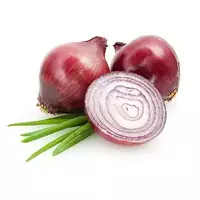Red onion

The fact that many culinary experts prefer red onions is not strange. This type of bulb onion is distinguished by its purple-red skin and white flesh with a reddish tint. Small bulbs are moderately sweet to taste, with no obvious signs of bitterness and very crisp.
Red onions are usually consumed fresh and are very often used to decorate salads. With far less searing and pungent properties, red onions, unlike white or yellow varieties, are simply amazingly good when combined with fresh vegetables or as an excellent addition to grilled meats. The attractive appearance of this plant allows you to make its pink and white slices an excellent decoration of almost any dish. Also, some enjoy braising or frying juicy red onion rings.
By the way, if you replace fresh red onions with pickled onions, you can easily introduce variety into such familiar vegetable salads, giving them a thin spicy note. To marinate fresh onions, you need to cut them into thin rings, and then round them with cool boiling water. It remains only for a few hours to pour the rings of red onions with marinade consisting of water, vinegar (you can wine), table salt, granulated sugar and a mixture of peppers with peas.
In this form, red onions retain their characteristic sweetness, while acquiring light sharpness and new taste nuances. Pickled red onions serve as an exquisite cheese supplement - in particular, they are good when combined with young goat cheese and olives.
It is noteworthy that red onions are available on sale almost all year round. However, when choosing this product in the store, always pay attention to the fact that its skin is thin enough, while the onion itself is dense texture, and there are no spots on the surface.
Red onion benefits
Regarding the benefits of red onions, it can be said that its main advantage in addition to sweetness compared to ordinary onions is that it contains almost twice as many natural antioxidants. Thanks to this property of red onions, it is classified as a product with a powerful anti-inflammatory effect.
The upper layers of the bulb are especially saturated with antioxidant flavonoids, so it is so important to carefully clean the onion, removing no more than 1 layer, so that as many nutrients as possible are preserved. It was found that the removal of one outer juicy layer leads to the loss of 20 percent of quercetin, as well as more than 75 of its anthocyanins.
Regular consumption of red onions allows the body to obtain a considerable number of different sulfur groups, which include diallyl sulfides: DDS, DMS, DTS and DND. The benefit of red onions in this case lies in the activation of the cysteine production process in the body, which contributes to a decrease in the level of intoxication of internal organs and weight loss.
red onion 41 kCal
Energy value of red onions (Ratio of proteins, fats, carbohydrates - ju):
Proteins: 1.4 g (~ 6 kCal)
Fats: 0.2 g (~ 2 kCal)
Carbohydrates: 8.2g (~ 33kCal)
Energy ratio (b | y): 14% | 4% | 80%
 Español
Español Français
Français Português
Português Русский
Русский 简体中文
简体中文 繁體中文
繁體中文 日本語
日本語 한국어
한국어 العربية
العربية Türkçe
Türkçe Қазақ
Қазақ Deutsch
Deutsch Italiano
Italiano Українська
Українська
